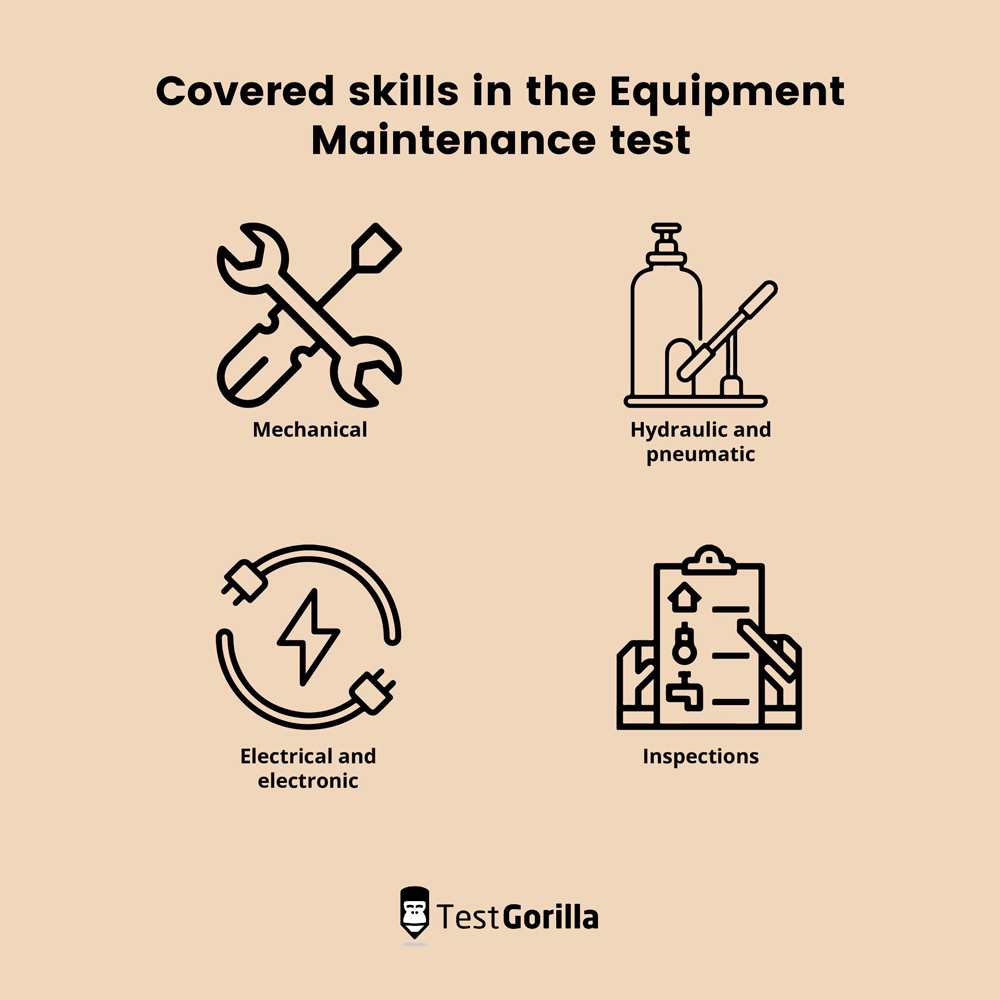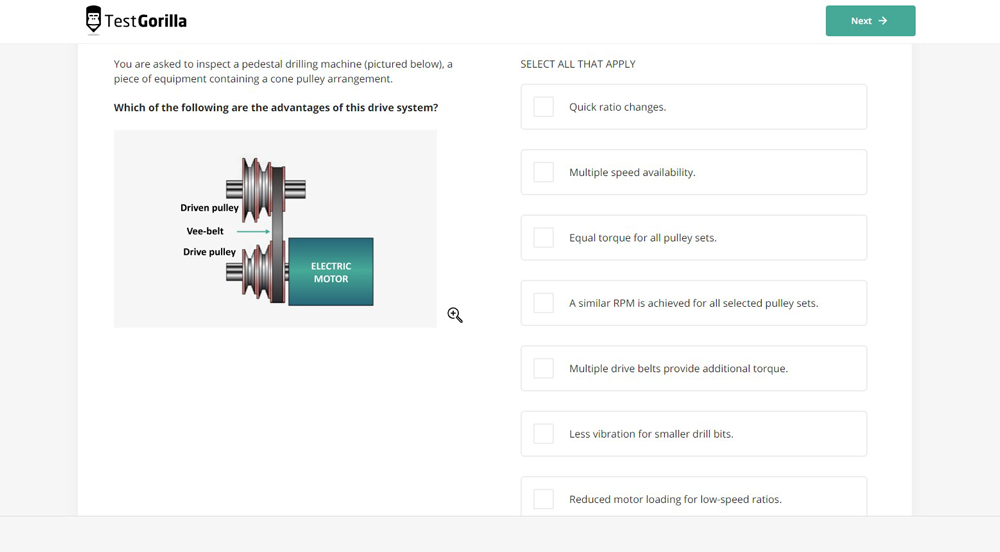How an online equipment maintenance test can help you hire the best technicians
Proper maintenance of equipment is essential to keep heavy machinery running safely and efficiently. It’s crucial that your maintenance technicians and mechanics have the right skills to carry out the job properly, but how do you know before an interview if your candidates possess the right level of competence for the role?
CVs won’t tell you the answer to this question with any degree of accuracy, but an equipment maintenance skills test will.
We’re going to look at how a maintenance test can help you find the best technicians faster, and how you can assess the hard and soft skills they need to succeed at the job. But first, let’s take a moment to focus on why you shouldn’t take chances when it comes to hiring heavy machinery technicians.
The risks of hiring maintenance technicians without the right skills
Everyone makes mistakes. We’re human, therefore we screw up every now and again, right?
Well, when many of us make a mistake at work it’s a nuisance, but one that we can hopefully fix without too much damage. What’s the worst that can happen, after all?
Unfortunately, there are a lot of people out there with jobs that they simply can’t afford to make mistakes in, including air traffic controllers, healthcare staff, emergency responders, and industrial equipment maintenance technicians. If they do mess up and the backup systems designed to catch any mistakes fail, the results can be disastrous and lead to loss of life.
Not all industrial equipment management carries such a burden of responsibility, but often safety of equipment operators and others rely on maintenance technicians troubleshooting and repairing their machinery properly.
If one of your staff uses a defective, faulty, or badly-repaired machine and is hurt (or worse still, fatally injured), your organization may be liable.
So, it’s imperative that your candidates have the right equipment maintenance skills to troubleshoot and repair heavy machinery. Being great at maintaining equipment isn’t, however, the only skill your candidates will need to be good at their job.
Essential job-related skills for maintenance technicians and how to test them
Construction, manufacturing, agriculture and transportation industries use heavy machinery and equipment to produce goods and provide services. The need for equipment maintenance technicians is expected to grow by a faster-than-average 19% from 2020-2030.
Technicians may have different job responsibilities depending on the type of machinery they are working with, but every technician must be able to ensure these tools are fully operational and safe.
Equipment technicians can work in a wide variety of industries, including construction, petrochemicals, manufacturing, agriculture and transportation. Depending on the industry they work in, equipment technicians may maintain and repair semi-trucks, bulldozers, buses, cranes, manufacturing lines, or industrial machinery.
All jobs require us to have a range of technical and soft skills in order to do our work well. Each role has its own skill requirements, and here we’re going to look at the skills needed for maintenance technicians.
Hard skills
As mentioned above, maintenance technicians will have different skill sets according to the type of machinery they work with, but a core set of technical abilities should include the following:
Basic heavy equipment
Electrical systems
Hand tools
Hydraulics
Diesel fuel systems
Preventive maintenance
Welding
Routine maintenance
Accurate record keeping
Ability to analyze blueprints and schematics
Understanding of computer testing technologies
Mathematics
Mechanics of materials
Thermodynamics
Calculus-based physics
Electrodynamics
Many maintenance technicians also hold popular professional certifications such as the Commercial Driver License (CDL), or the OSHA Safety Certificate.
The best insights on HR and recruitment, delivered to your inbox.
Biweekly updates. No spam. Unsubscribe any time.
How to use our Equipment Maintenance test
That’s quite an impressive list of technical skills. So, how do you test candidates to ensure they have the level of competence you need?
Our Equipment Maintenance test is the answer to your problem.
This test is written by a subject-matter expert with over three decades of international experience in engineering and heavy equipment management in the construction, oil and gas, mining, manufacturing and marine fields.
It’s designed to evaluate a candidate’s technical skills and abilities to comprehend, evaluate, and implement equipment maintenance for commonly encountered heavy equipment.
The Equipment Maintenance test focuses on three broad equipment categories: mechanical, hydraulic and pneumatic, as well as electrical and electronic. The questions focus on understanding system function, testing, adjustment, diagnostics, and overhauling. The skills associated with inspections are also covered in this test, which includes understanding manuals as well as failure analysis.
This test is full of images and diagrams of machines, systems, and tools with which an intermediate technician should be familiar. These images are important because on-the-ground skills require visual literacy. Below are a couple of sample questions from the test to give you an idea of how thorough the questions are:
The question above asks candidates to choose all the answers that describe the advantages of the specific drive system, and the one below tests their knowledge of risk assessment in equipment:
Although not every maintenance technician may have worked on every type of machine in this test, the machines chosen for the test questions contain core systems that all intermediate technicians should be able to evaluate.
In order to gain a broader understanding of your candidates’ other skills you can build an assessment around the Equipment Maintenance test. In the next section we’ll look at some useful test options to consider adding to an assessment for an equipment technician.
Soft skills
You can’t underestimate the power of soft skills in any industry. Just as you are careful when ensuring a candidate has the hard skills and technical experience for a role, it’s important to apply that same diligence when it comes to evaluating soft skills.
Doing so helps to ensure new employees are set up for success, and you can save your organization money and time by assisting in reducing employee turnover.
TestGorilla’s pre-employment assessments enable you to test candidates for a variety of job-related skills in one sitting. You can add up to five tests to each assessment from the following categories in our test library:
You may choose to test for math, language, software, or any other tech skills in addition to the Equipment Maintenance test. Below are some soft skills for maintenance technicians you might consider testing for:
Critical thinking
Equipment technicians need to use their critical thinking skills in order to analyze blueprints and schematics. This soft skill can also help with troubleshooting issues and developing solutions. Our Critical Thinking test is an ideal addition to the equipment maintenance test.
Those who do well on the Critical Thinking test tend to have a well-trained working memory. If you are looking for candidates who are independent thinkers, able to solve complex problems, generate innovative solutions, and check candidates’ overall analytical skills, this test is a great place to start.
Communication
Maintenance technicians may need to explain complex ideas in simple terms to ensure everyone can understand the information they convey. This skill is crucial when it comes to relaying safety information regarding the machinery that technicians work with. Excellent communication skills can also help staff develop and maintain interpersonal relationships with coworkers and other industry professionals.
TestGorilla has developed a Communication test to evaluate how well candidates interact with others. Top scorers on this test can listen attentively to others, communicate with confidence and open-mindedness, and can offer empathy and feedback at the right place and time.
Teamwork
Equipment technicians often work with a team of other maintenance professionals and engineers. Ensuring a candidate has a good grasp of teamwork and team-oriented personality traits helps to resolve issues quickly and also prevents resentment and frustration growing in other team members.
Our Big 5 (OCEAN) test is a personality test based on the five-factor model (FFM) theory that categorizes five broad trait dimensions as the basis of different personalities. This test shouldn’t be used to make hiring decisions, but it is intended to give you a deeper insight into the personality traits that characterize candidates’ behavior.
This test also provides insight into applicants’ strengths and opportunities for improvement, and how they relate to others. For example, personality testing can provide pointers on how well a candidate might fit within your existing team.
We have a range of personality tests, and if you’re interested in this area you might find our post covering your hiring team’s guide to personality tests useful for further reading.
Time management: Maintenance technicians often work on several maintenance projects at the same time. Having excellent time management skills can help candidates address maintenance issues promptly. It also helps them schedule preventative inspections to increase the lifespan of equipment and machinery.
Here at TestGorilla, we’ve developed a Time Management test designed to evaluate candidates’ skills in prioritizing tasks according to deadlines, importance, and impact. Those who do well on this test are able to plan their work in the most efficient way, and to execute tasks effectively. This test also assesses candidates’ ability to reflect on their work, monitor its outcomes, and communicate important information to others
Physical fitness: Although we don’t offer physical fitness tests, being an equipment maintenance technician requires physical strength and stamina, as well as excellent hand-eye coordination.
Equipment maintenance often involves getting into, and working in, cramped spaces. You should be clear about this in any job description, and ask candidates about their level of physical fitness in the application form.
Hire smarter: Find your next maintenance technicians with TestGorilla
We hope this article has been useful showing you how to use the Equipment Maintenance test to hire a skilled maintenance technician. It can be hard to decide where to start, especially if you aren’t experienced in heavy equipment maintenance yourself.
If you’re ready to ditch the CV pile and join us in forging the future of skills-based hiring, and want to know more about how to get the process started, our comprehensive guide to creating an assessment answers your questions and will get you up and running in no time.
Sign up for your TestGorilla free plan (it takes less than a minute) to get started on building your first assessment.
If you want more information or to see how our products work first-hand, book a free 30-minute live demo with our sales team, who will be pleased to answer any questions you may have.
Related posts
You've scrolled this far
Why not try TestGorilla for free, and see what happens when you put skills first.























